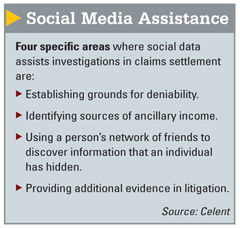 It's clear that social media usage has risen in all age groups, and the large swaths of information posted by individuals reflect preferences, lifestyles, habits, and, in some cases, neuroses. Insurers can use this mounting social data to create a real-time risk profile while shaping more effective claims and underwriting operations, Celent explains in its new report, "Using Social Data in Claims and Underwriting."
It's clear that social media usage has risen in all age groups, and the large swaths of information posted by individuals reflect preferences, lifestyles, habits, and, in some cases, neuroses. Insurers can use this mounting social data to create a real-time risk profile while shaping more effective claims and underwriting operations, Celent explains in its new report, "Using Social Data in Claims and Underwriting."
Although there has been much buzz about the potential full impact of harnessing social data, until fairly recently few strategic solutions had surfaced. But Celent is leading the discussion on broader applicability, presenting a five-step model to operationalize social data. The model outlines the major decisions that should be addressed in implementation: what data should be used, what technical strategy should be adopted, how to acquire the data, how to analyze it, and how to integrate social data with existing operational systems. Standard Inputs into Risk Evaluation
Integrating these data inputs into insurers' existing process and automation environment will drive more optimal results in both claims and underwriting, assert Celent Analyst Craig Beattie and Senior Analyst Mike Fitzgerald, authors of the report. They stress that one of the keys to successful implementation will be tempering enthusiasm with the reality that social data is still in its formative stages.
"This [social data] implementation will not be without challenges," Beattie says. "Key techniques must be developed or enhanced, including reliable authentication methods, improved data extraction tools, and more advanced analysis tools."
"It must also be remembered that, at one time, previous innovations such as multi-tiered automobile pricing, predictive analytics, and the use of tele-underwriting in place of attending physician statements, were viewed as optional changes to long-standing insurance processes," he adds. "This transition will not be without challenges."
P&C insurers will need to develop techniques or augment existing ones. "Additionally, regulation concerning the use of social data is evolving more slowly than the technology and potentially will significantly impact the use of information collected from these public forums," the authors explain.
In the report, Beattie and Fitzgerald provide a more in-depth overview of current and future uses of social data in core insurance operations. By identifying the policy decisions that should shape an insurer's social information strategy while raising technical issues and possible solutions related to the unique characteristics of social data, Celent intends to equip insurers with practical considerations to unlock the true value of social networks. Pervasive Fraud
Among other topics, the Celent analysts discuss how staged automobile accidents and "soft" fraud— over-reporting damaged values after a fire, for example—pose a significant drain on the industry, citing some troubling statistics from the National Insurance Crime Bureau (NICB), including: an estimated 10 percent of all U.S. P&C insurance claims are fraudulent; and workers' compensation fraud may cause insurers as much as $5 billion on an annual basis.
As such, Celent stresses that it is in the collective interest of both insurers and insureds (at least the honest ones) to reduce the amount and cost of fraud. Social networking data is already having an impact in this area, and the potential benefits are significant.
Want to continue reading?
Become a Free PropertyCasualty360 Digital Reader
Your access to unlimited PropertyCasualty360 content isn’t changing.
Once you are an ALM digital member, you’ll receive:
- Breaking insurance news and analysis, on-site and via our newsletters and custom alerts
- Weekly Insurance Speak podcast featuring exclusive interviews with industry leaders
- Educational webcasts, white papers, and ebooks from industry thought leaders
- Critical converage of the employee benefits and financial advisory markets on our other ALM sites, BenefitsPRO and ThinkAdvisor
Already have an account? Sign In Now
© 2025 ALM Global, LLC, All Rights Reserved. Request academic re-use from www.copyright.com. All other uses, submit a request to [email protected]. For more information visit Asset & Logo Licensing.








